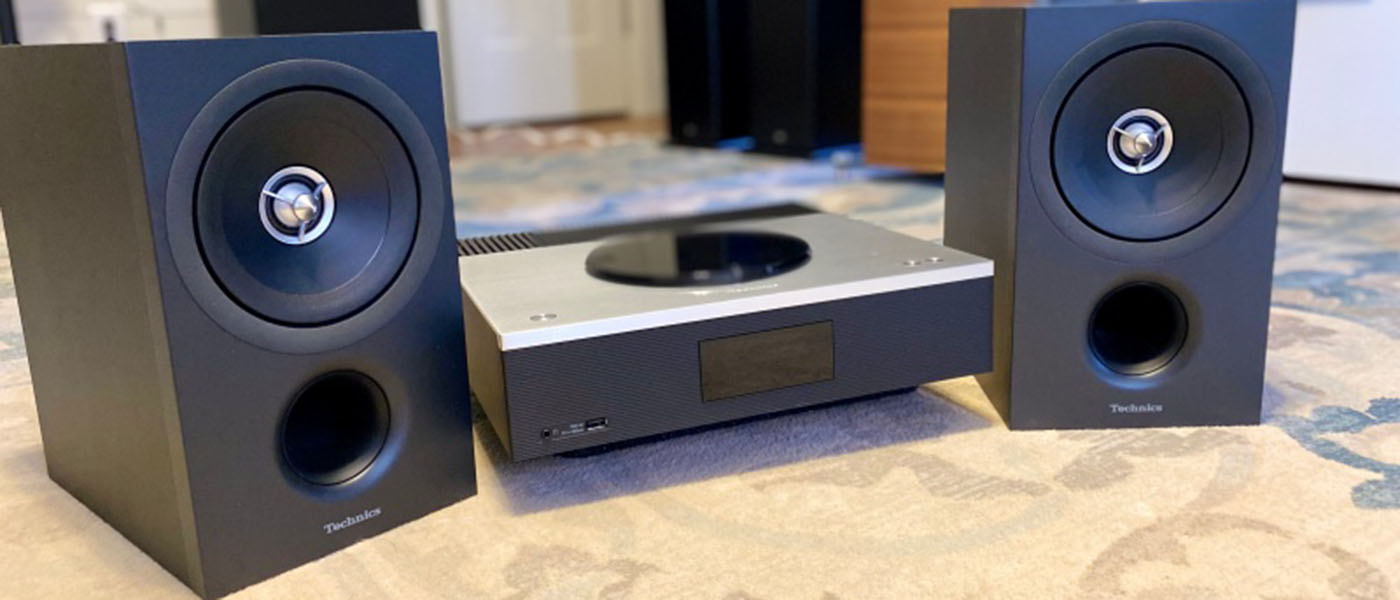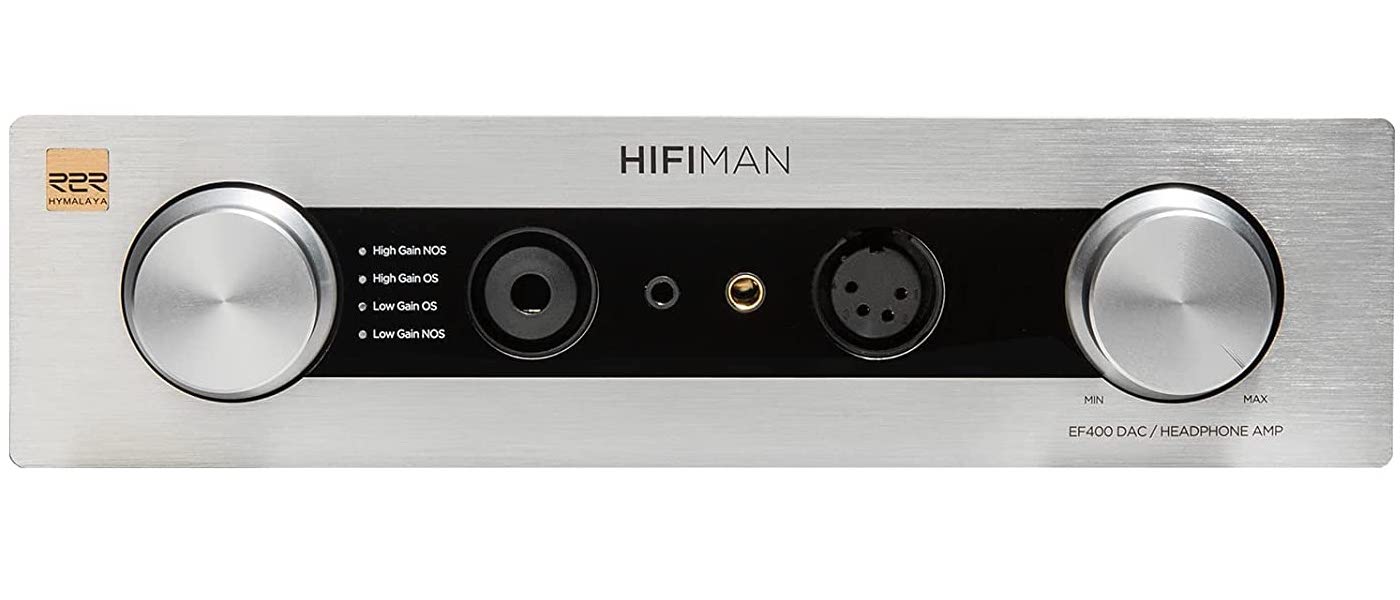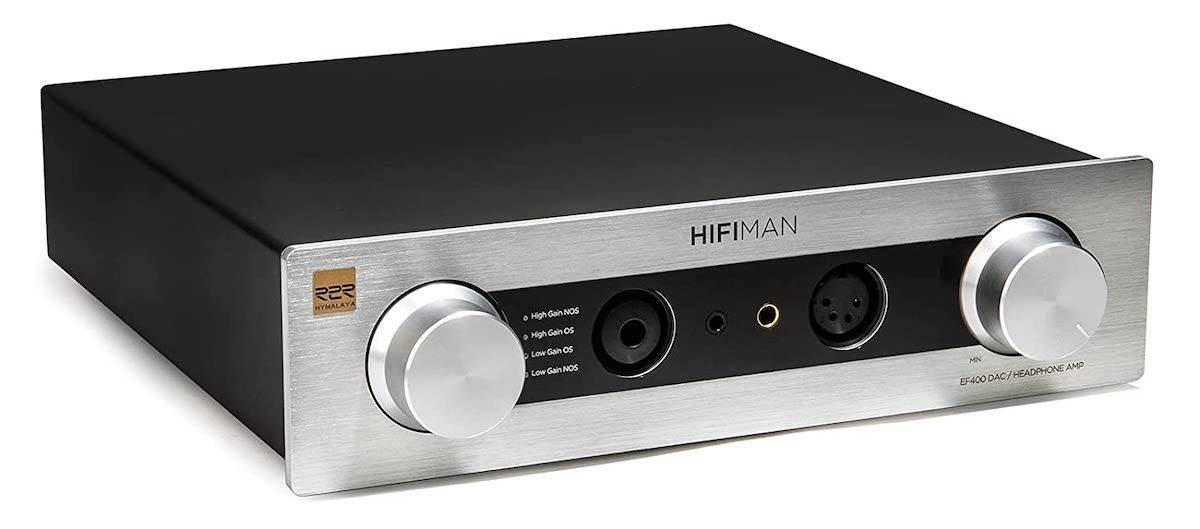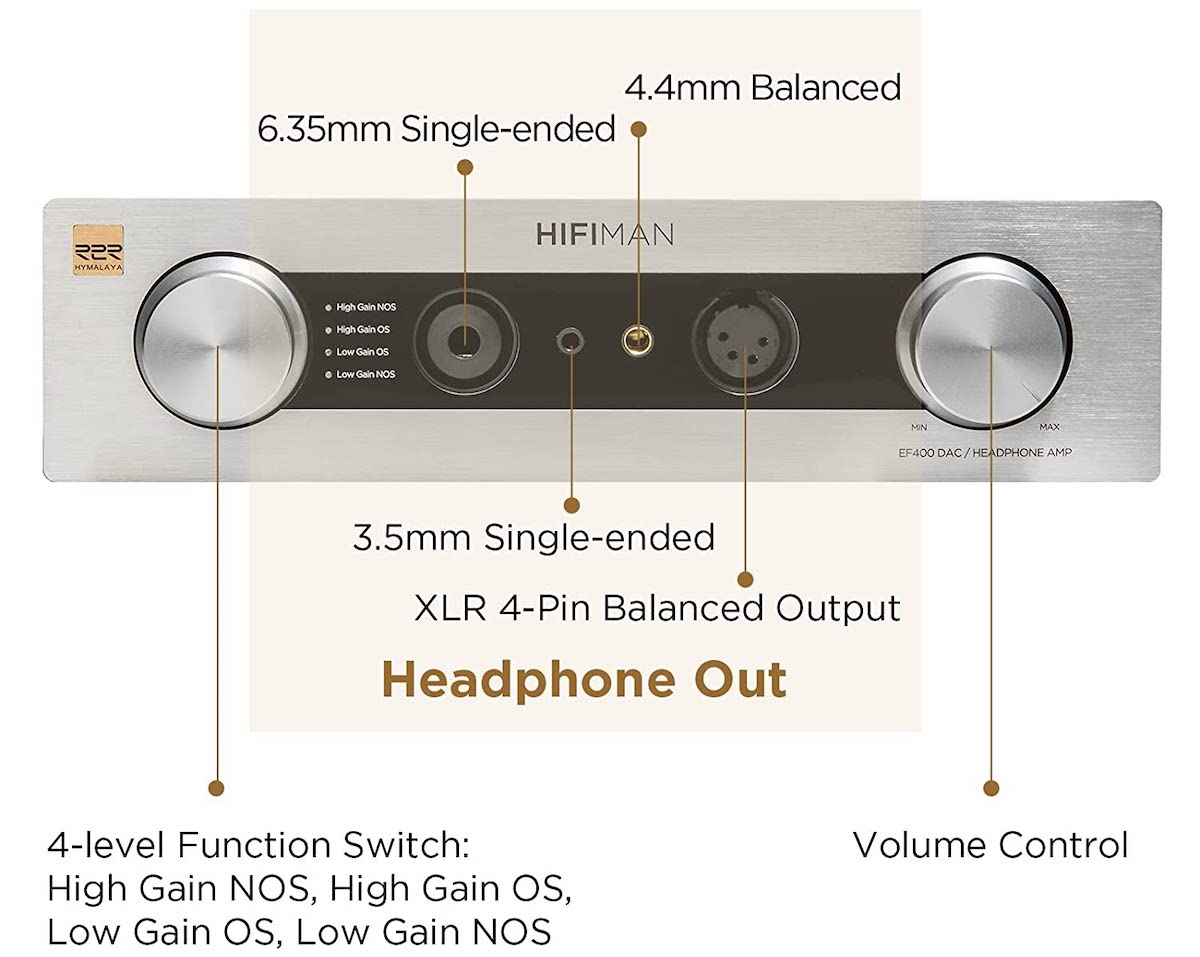HIFIMAN EF400 DAC Highlights
- Four headphone connections on the face of the unit
- Four separate output settings to accommodate a wide variety of headphones
- Balanced three-pin XLR outputs, a rarity at this price point
- Can be used to improve the sound of a wide variety of devices with USB output, such as computers, mobile phones, and portable music players
- Runs cool
- Supports PCM signals at up to 24-bit resolution
The EF400 uses HIFIMAN’s new Himalaya R2R DAC, which uses an array of highly accurate resistors for a “ladder” method of conversion. This DAC supports common PCM signals with a maximum 24-bit resolution. Its headphone amp offers the fidelity of Class A design and the efficiency of Class B architecture and can output up to 4.4W per channel.
The front panel gives you four headphone outputs, so you can listen to a wide variety of headphones with the EF400. On the back are input jacks for USB-B and USB-C, and both RCA and balanced three-pin XLR outputs.
The HIFIMAN EF400’s suggested retail price is $599US. That is a lot of versatility for the price, but how does it sound?
Configuration:
Headphone amplifier and DAC with four headphone outputs and two types of USB input.
Maximum Power Output:
4.4W per channel
Channel Separation:
125 +/- 3dB
Signal-to-Noise Ratio:
118 +/- 3bB (A-weighted)
THD+N (Line Out):
Between 0.002% and 0.004%
Front Panel Layout:
Four-level function switch: High Gain NOS, High Gain OS, Low Gain OS, Low Gain NOS
6.35mm single-ended headphone output
3.5mm single-ended headphone output
4.4mm balanced headphone output
XLR four-pin balanced headphone output
Volume control knob
Bottom Panel Layout:
Selection switch for 115V or 230V AC
Digital Inputs:
USB-B input, one
USB-C, one
Analog Inputs:
XLR analog inputs, one pair
XLR analog outputs, one pair
Analog Output:
XLR analog, one pair
RCA analog, one pair
TITLESPEC:
DESCRIPTION
Dimensions:
9.8” long x 8.9” wide x 2.4” tall (247mm long x 228mm wide x 61mm high)
Weight:
6.8 pounds (3.08 kilograms)
MSRP:
$599USD
Website:
Company:
SECRETS Tags:
HIFIMAN, DAC, digital audio converter, headphone, ladder DAC, DAC Reviews 2022
The HIFIMAN EF400 is in a black metal box with a silver brushed aluminum face. On the left of its face is a four-position function switch and on the right is the volume control. The four headphone outputs are set within a black inlay between the potentiometers. The only lighting is a small white LED which indicates the position of the four-function switch on the left.
On the back panel are three-pin XLR and unbalanced RCA outputs. Next to those are the USB-B and USB-C inputs. Then there is the receptacle for a standard IEC power cord and an on-off switch. On the bottom is a voltage selector to choose between 115V or 230V AC power sources. Those two pairs of outputs mean you can use the EF400 with a preamplifier.
Those USB inputs enable you to attach a wide variety of devices to the EF400. Most computers, mobile phones, and portable music players have a USB output, so you can run their audio output through the EF400. As a test, I attached an Apple iPhone 11 with a Lightning to USB Camera Adapter, and it just worked. An added bonus is that the EF400 provided enough power through USB that I did not have to attach a separate USB power source through the Camera Adapter, which happens with some external DACs. So, you can be confident that the EF400 will readily accept your device’s USB output.
On the front panel, you get four headphone ports. The 4.4mm and XLR four-core ports are balanced and suitable for driving high-sensitivity in-ear headphones. It’s worth noting that balanced outputs can theoretically generate three to four times more power than unbalanced outputs. The 6.35mm and 3.5mm ports are unbalanced and are suitable for driving low-sensitivity headphones
Secrets Sponsor
Its size belies its weight. It weighs nearly seven pounds, due mostly to the substantial oxygen-free copper wire wound toroidal power transformer inside. The HIFIMAN EF400’s high-current headphone amplifier utilizes a series of 30,000uF large capacitors to handle power management. It will output up to 4.4W to each of its headphone ports, and you can listen through more than one port at once.
A lot of the EF400’s magic lies in its Himalaya R2R DAC, which is the result of five years of focused product development by HIFIMAN’s engineers. The Himalaya is a discrete R2R DAC module based on a custom algorithm programmed into a field-programmable gate array (FPGA) chip. This algorithm reduces electrical interference between the chip and peripheral components. Also, an R2R DAC uses a series of precision resistors to convert digital binary numbers into analog output signals.
The unit is also fully balanced. Its four-channel differential structure features a DAC, buffer, and active filter to provide a fully balanced output from a Class A-B DAC/amplifier. The four-channel fully differential amplifier circuit features a maximum output of 10.8 Vrms (THD <1%) on a 36 Ohm resistor equivalent load.
The four-level function switch on the left front enables you to find a setting for whichever pair of headphones you’re listening to. You can choose high or low gain, and oversampling (OS) or non-oversampling (NOS). You can adjust the settings on-the-fly, but you will hear a second of silence between settings. When oversampling, the DAC uses interpolation to provide a higher resolution to the source music. The HIFIMAN EF400’s DAC accepts pulse-code modulation (PCM) signals at up to 24-bit resolution, so you may find you do not need to oversample your high-resolution music. But it is nice to have the option.
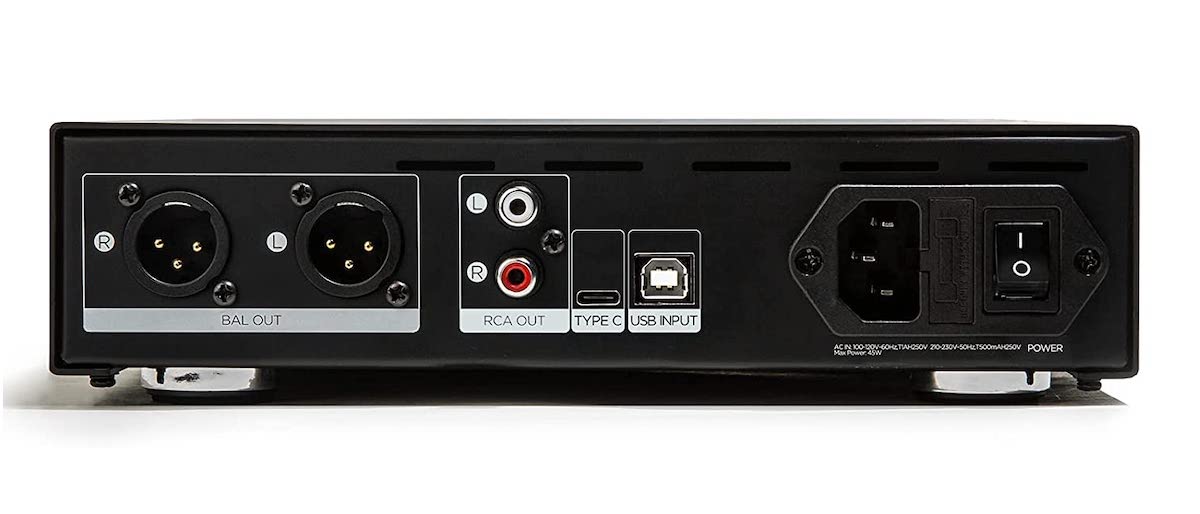
While the EF400 performed very well with a computer or portable device as a source, I would like to see the addition of TOSLINK and/or Coax digital inputs. I can understand if that functionality was omitted to enable HIFIMAN to meet a price point. As far as I can tell, there are no CD transports with USB output. One possible solution to this challenge is the rumored Urd CD transport from Schiit, which may have a USB output, but the release of that component is pure speculation at this point. But this is a minor concern at best.
I attached the HIFIMAN EF400 to one of the USB ports on the back of my 2017 Apple iMac with an inexpensive USB-C cable. The macOS operating system automatically recognized it as a sound source. The unit’s manual makes no mention of a driver for Windows computers or compatibility with ASIO, for what it’s worth. I should point out that if I did purchase an EF400, I would definitely invest in a good-quality USB cable. I’ll be sure to read Glenn Young’s Audioquest USB Cable Shootout before I make that purchase.
Secrets Sponsor
The HIFIMAN EF400 made every pair of headphones I have sound good, and, in some cases, better. My Sennheiser HD6XX headphones ($240USD) have a 300 Ohm impedance and 103dB sensitivity. Driven by the EF400 in the high-gain oversampling setting they revealed more inner detail than I thought they were capable of. The soundstage in particular improved considerably. This was a very nice and unexpected improvement to a mid-priced pair of headphones.
Fortunately, I still have on hand the excellent HIFIMAN Arya Stealth Magnet headphones. These are planar magnetic headphones with a 32 Ohm impedance and 94dB sensitivity. They also sounded best for me with the high-gain oversampling setting.

Lamp “Lamp Genso”
With Apple Music as a source playing the 16-bit/44.1kHz ALAC format, Japanese band Lamp’s album Lamp Genso was satisfying and engaging. This is a rather low-fi recording at points, with lots of acoustic guitar and overdubbed vocals. I think this music is a good test of the HIFIMAN EF400’s headphone amplifier because even though there is some distortion in the recording, the distortion was not overemphasized, even when listening through the Sennheiser HD6XX headphones. The fidelity of the low fidelity was respected, as it were, so the album’s light and breezy yacht rock qualities still shone through.
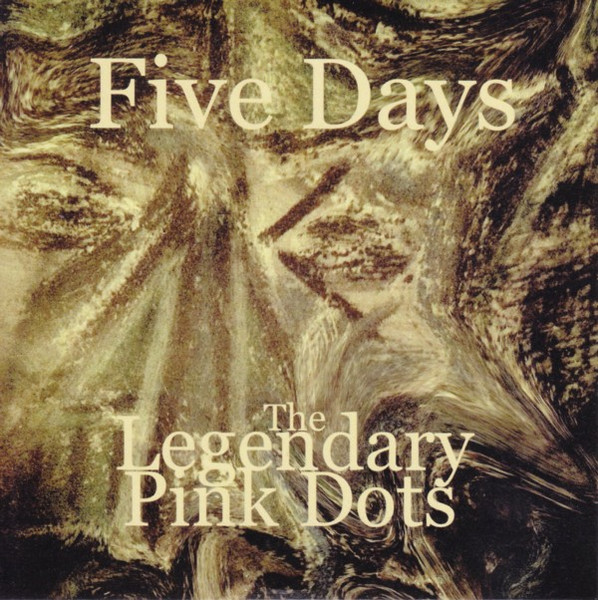
The Legendary Pink Dots “Five Days”
The Legendary Pink Dots, Five Days, in 32-bit/44.1kHz FLAC files played through the VLC program. I bought these files from the band through Bandcamp.
Even though the documentation mentions the Himalaya DAC’s 24-bit resolution maximum with a PCM signal, the EF400 played these 32-bit files perfectly well. Listening to the Arya Stealth Magnet headphones, became a fully immersive experience. Band leader Edward Ka-Spel is a master at building artificial soundscapes out of layered sampled sounds and field recordings and listening to this album I was occasionally surprised by the hoot of an owl that seemed to originate in my own backyard. The music of the Legendary Pink Dots can get very dense at times, with all kinds of different sounds panning around the soundstage, and the HIFIMAN EF400 enabled the headphones to maintain the distinct imaging of each sound without blurring or confusion. Even with challenging music, I felt like I could listen to the Arya Stealth Magnet headphones driven by the HIFIMAN EF400 for hours on end.
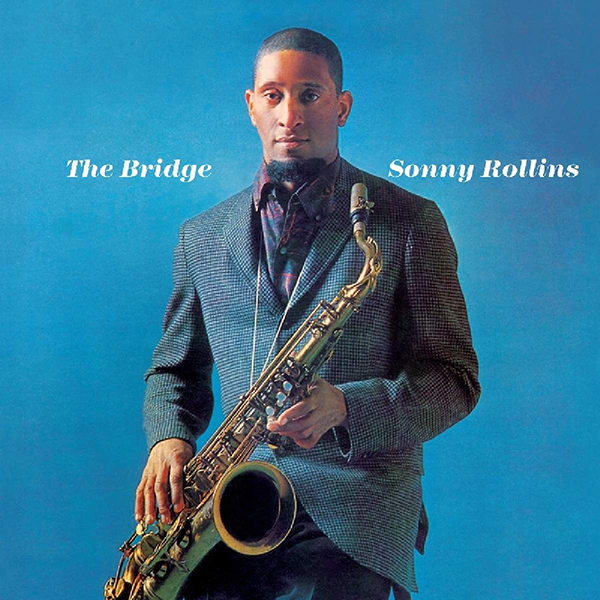
Sonny Rollins “The Bridge”
With this combo I listened to Sonny Rollins The Bridge played in 24-bit/176.4kHz through Qobuz. This is the album Rollins made after a self-imposed period of isolation, where he played his saxophone on a bridge in Manhattan for fifteen or sixteen hours a day. He did this every day of the summer from 1959 to 1961. He also started practicing yoga during this time. I think this album showcases Rollins’s new dedication to his craft with deep and thoughtful conversations through instrument and sound. The interplay between Rollins and guitarist Jim Hall is a wonder to experience. During the song “Where Are You” the HIFIMAN EF400 let me hear many of the fine details of Hall’s hollow-body guitar tone, giving me every detail of how he coaxed emotion out of his instrument. The soundstage was very well represented, with each of the four instruments occupying a solid position in the front-to-back and side-to-side axes. The full size and woodiness of the bass fiddle came across very well and the drums and cymbals stayed sharp with lots of soundstage echo. The entire band burns hot enough to incinerate a city block during “John S.” but the HIFIMAN EF400 did not ever lose its composure.
The Focal Clear MG headphones have a 55 Ohm impedance and 104dB sensitivity. These headphones excel at retrieving low-level detail, so I found that the EF400’s oversampling mode occasionally did not improve the listening experience, but that depended on what I was listening to. It’s great to have that option, I believe.
The HIFIMAN EF400 is a DAC/headphone amplifier that provides great sound quality and will power a wide variety of headphones. Its $599US selling price delivers quite a bit of versatility and it should be easy to implement within a wide variety of devices with USB output.
- Great sound quality that provides detail without being fatiguing
- Can drive many types of headphones and more than one pair at a time
- Four types of headphone connections
- Four different gain and oversampling/non-oversampling settings
- Can be used to improve the sound of a wide variety of devices with USB output, such as computers, mobile phones, and portable music players
- Has both unbalanced RCA and balanced XLR outputs so it can be used with a preamplifier
- TOSLINK or coaxial digital input for CD transports
The HIFIMAN EF400 is a DAC/headphone amplifier that provides great sound quality and will power a wide variety of headphones. Its $599USD selling price delivers quite a bit of versatility and it should be easy to implement within any computer or portable device with USB output. Without fail, it impressed me with every set of headphones I powered with it. It’s the kind of headphone amplifier and DAC that will reward you when it’s paired with high-quality headphones.


